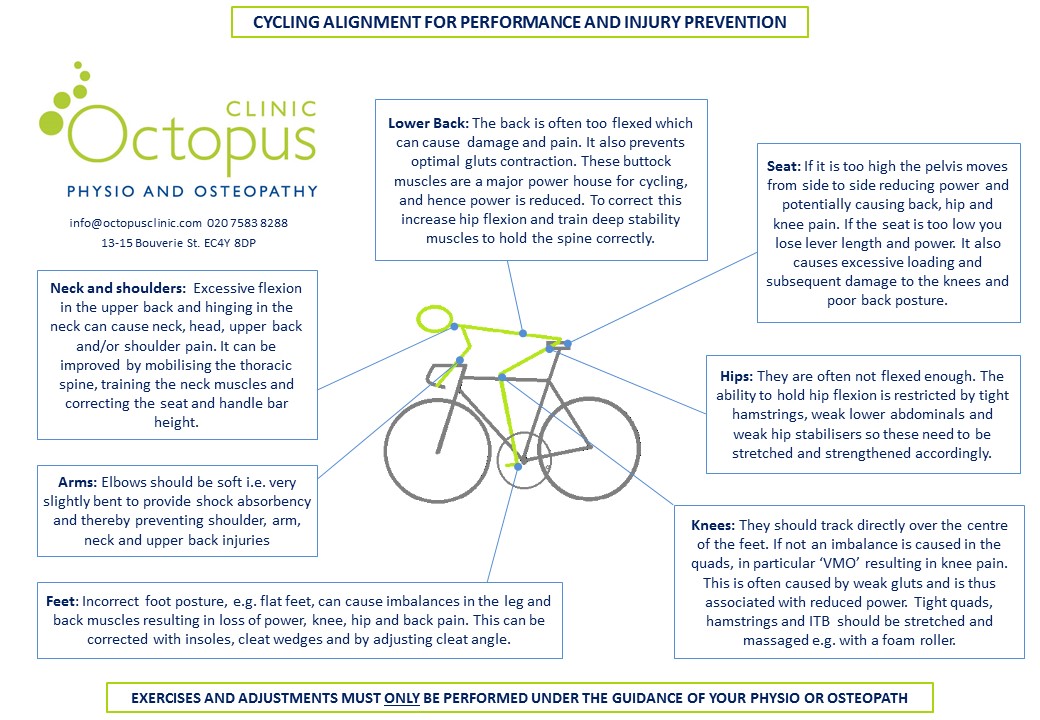Cycling
A huge number of our patients cycle either competitively or as a means of transport, we have Physiotherapists and Osteopaths that are specialists in cycling.
We provide cycling assessments so that, whether you are competing in the Etape or simply cycling to work, we know how to tweak body position and bike set up to enable recovery and improve performance.
If you have an injury you need to see an experienced Physiotherapist who will get you back on your bike ASAP.
Apart from those resulting from a fall, cycling injuries are normally as a result of:
- Incorrect body positioning or posture on the bike
- Inefficiencies in cycling technique
- Incorrect bike set up
- Weaknesses or imbalances in the muscles that enable good biking technique
- Stiffness in joints or soft tissues that prevent good bike technique
- A combination of the above
Common cycling injuries include the following.
- Pain at the front of the knee anterior knee pain which can be caused by:
- Pain at the side of the knee could be ITB friction syndrome.
- Pain in the neck or upper back could be caused by incorrect neck posture.
- Back pain, sometimes radiating into the legs could be a number of different conditions.
- Hip pain
Remember, it is important to have your pain fully assessed and treated by a Physiotherapist or Osteopath to prevent further damage occurring.
Please see below for tips on cycle set up and body positioning

-
Clicking Shoulder
Clicking or crunching in the shoulder can be caused by a number of things. Most people fear that the clicking is caused by bone hitting bone. However, thankfully nowadays this is rare. If you have this, it is likely that for many years you have been suffering severe pain and...
Read More -
Patella Tendinopathy (pain front of knee below knee cap)
Please read how the knee works before reading the following. It can occur in any propulsive, impact based sports or as a result of a change in loading to the tendon. The patella (knee cap) tendon extends from the bottom of the knee cap and inserts into the tibial tuberosity...
Read More -
Clicking ankles or feet
Clicking or crunching in the ankles or feet can be caused by a number of things. Most people fear that the clicking is caused by bone hitting bone. However, thankfully nowadays this is rare. If you have this, it is likely that for many years you have been suffering severe...
Read More -
Stiff Thoracic Spine
The thoracic spine – middle and upper part of the back - is the stiffest part of the spine due to the ribs attaching here, but it commonly becomes too stiff as a result of poor postures. Please click here to learn correct sitting posture. Thoracic spine stiffness puts more...
Read More -
Carpal Tunnel Syndrome
We often find that this is over diagnosed and that often the arm and hand pain (and weakness) is actually being caused by a tendinopathy that is fully treatable with physiotherapy. However, true carpal tunnel syndrome is caused by irritation of the median nerve that runs though the wrist joint...
Read More -
Neck Pain/Tightness
Mild neck pain and/or tightness that comes on slowly is commonly due to the upper back rounding forwards and the chin pointing forwards and upwards, which increases muscle and nerve tension and may cause pins and needles or pain in the arms and hands. Sometimes, breathing becomes restricted due to...
Read More
Common Injuries
-
ITB and TFL release
Please click here to read how the knee works before reading the following.
Read More -
Foot and ankle exercises
There are a variety of exercises that are great for your feet and ankles including: 1) Foot self-massage exercise 2) Eccentric calf strengthening 3) Foot muscles strengthening 4) Concentric calf strength and ankle instability exercise
Read More -
Train deep core muscles
The following exercise should be performed under the guidance of your Physiotherapist or Osteopath to ensure you are doing it correctly and prevent aggravation of your condition. Please click here to learn how the back works before reading the following.
Read More -
Breathing and relaxation training
Many spinal, hip and shoulder problems can be helped by retraining breathing habits and releasing the structures involved in breathing, such as the diaphragm and thoracic spine.
Read More -
Glut/ VMO/ leg alignment exercise
Please click here to read 'how the knee works' before reading the following. This exercise trains the lateral glute muscle fibres, lower limb alignment, VMO (the inside part of the quads muscle) and stretches the calf so is a big hitter – if you can get it right! You will...
Read More -
Stretching
A note on static stretching v dynamic stretching I bet you can't remember the last time you saw elite athletes doing a static stretches pitch-, track- or court side pre-performance. That is because research now shows that static stretching is not advisable before exercise. This is because it slows...
Read More
Exercises
Related News
-
Can you lift your testicles? Training the pelvic floor for...
As a physiotherapist I use that first sentence surprisingly frequently....
Read More -
Multiple Articles on Tennis Injuries, Knee Pain, Power lifting, Neck...
Lucy Macdonald recently wrote a series of articles for...
Read More -
‘I have back pain, what is causing it and what...
As a physiotherapist this is probably the most common question I get...
Read More -
Five Injury Busting Triathlon Tips from Specialist Physiotherapist
Triathlon Physiotherapist I have been a Physiotherapist since 2005...
Read More